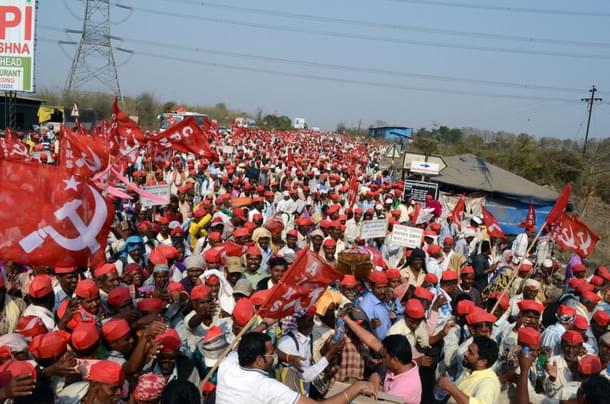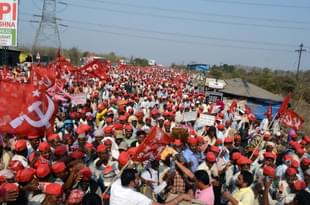Politics
The Great Communist Charade: Forget The Farmer, Focus On The Optics
Pratyasha Rath
Mar 13, 2018, 04:25 PM | Updated 04:22 PM IST
Save & read from anywhere!
Bookmark stories for easy access on any device or the Swarajya app.


Like all communist agitations, this one too needed a little blood, and that came from the feet of the farmers.
Long after you have switched off your phone, the image of a red, bloodied foot of a woman with the skin peeling out, will linger in your mind. The black and white shots of a broken rubber slipper and of calloused, tired feet which have marched for 200 kilometres will bring out the guilt that you keep hidden inside you somewhere. The image of the young, conscientious boy handing over a packet of biscuits to a farmer will silence that small question that propped up in your head about your own struggles and expectations. And finally, when you see the carefully filtered image of the frail man in a dirty white kurta you will forget about the red cap on his head and the red flag in his hand.
This is how the Left performs a protest from college campuses to television studios to the streets of the financial capital. Carefully selected images, exhibits of pain and deprivation, moral high standing that triggers the guilt in most and a unified, concerted push by the ecosystem to use empathy to morally degrade sceptics. The strength of the ecosystem that the Left has nurtured allows them to separate the farmer from her red cap and she is suddenly not a communist. She is just a farmer who we all have failed! But, if that same farmer tomorrow walks with a saffron flag, she will become a mercenary of the Fascist order and will be stripped off all emotional resonance. Just like the Dalit asking for a Ram temple is not Dalit enough!
The images that you see and the assertion that you hear of, hide a moral code which has germinated from making misery a spectacle. And with an almost unchallenged monopoly on consensus creation, the moral conundrum is deepened further. Power is negotiated based on the basis of this moral code. That is why the image of a woman leading the defence forces can be dismissed as tokenism but that of a woman marching with a red flag is celebrated as power.
How can you then tell this farmer with the red cap that agriculture is in a rut and she needs to ask the government for help to transition out? And importantly, how do you tell her that she is not just a farmer but a political actor aligned to an ideology that is being routed globally. There is no way to say all this and escape without being labelled insensitive or elitist.
The Left across the world has mastered the idea of performing a protest. And the performance works best when it can tap into our inner guilt about our social positions. The Mumbai march was just another manifestation of it especially, when the coordinated hashtags and images forced the attention away from the legitimacy of the demands and the effectiveness of the solutions. A discussion on market linkages or the futility of loan waivers leading to income security would only lead to one being labelled anti-farmer. And that is the bane of the Right wing globally. Logic and ambition does not have the emotional resonance of deprivation. So, the story of a person wanting to become rich and succeed against all odds will not make us feel as invested as the story of a person who is struggling to stay afloat. If a politically neutral person had to choose between helpless farmers and a hapless sector, you know where the discussion will lead.
It is a well-known fact by now that Girish Mahajan, the Minister of Water Resources and Irrigation, Government of Maharashtra, had met the leaders of the march in Nashik, before the march commenced. The same discussions which ultimately led to the suspension of the march in Mumbai, was conducted before the rank and file marched for 200 km. Then why was the march necessary? The express purpose again was the performance which would stay in the minds of the people. That is why, the bare feet and the broken slippers marched for three days with red flags in their hands and red caps on their heads. They marched because their leaders wanted their calloused feet to scream that they may be electorally vanquished but they can put up a performance of protest that will make others stand and stare. The march and the coordinated campaign around it from ideologically aligned consensus creators was an assertion of relevance after the rout in Tripura. And like all communist agitations, needed a little bit of blood which came from the foot of the farmer.
Also take a look at how the demands were crafted and articulated. Loan waivers, Swaminathan committee recommendations, takeover of agricultural land while as the Chief Minister of Maharashtra clarified that the major demand was about land settlements under Forests Rights Act. The performance demanded that certain things be hushed up so that the narrative could be set for the three big agrarian states that are heading towards elections. It is not that the agrarian crisis is not relevant and certainly not that it is being ignored. The current Union budget addressed everything from minimum support price to agri-marketing reforms. The Maharashtra government through the flagship Jalyukt Shivir has brought water to many arid regions of the state. The way in which the Devendra Fadnavis government handled the issue also shows immense maturity and the farmers returned to their respective homes with the assurance that their demands will be met.
In the end, politics boils down to base human emotions. While the Left uses empathy and the romance of trying to do something to assuage your guilt, the Right relies on the ambitions and aspirations that each one of us have in us. The fight of the Left and the Right is the fight between romance and ruthlessness, emotion and logic.
Through the coordinated, evocative messages which bring out the romance in revolution, the Left can easily and at will transition to being ruthless. From Cambodia to Kerala, the list of dead bodies will stand testimony to what happens when you do not share the romance of revolution. But, the Right cannot evoke romance because pragmatism never quite connects as pathos. The roads and rails and gas cylinders and toilets speak the story of hope and it is perhaps time to learn a little from the Left and speak loudly about it.
Pratyasha Rath is a consultant working in the social development and political sector.





